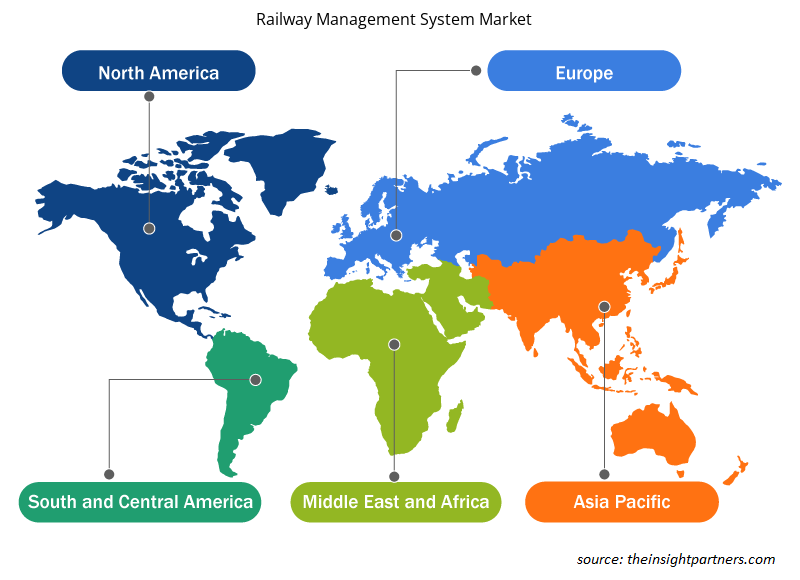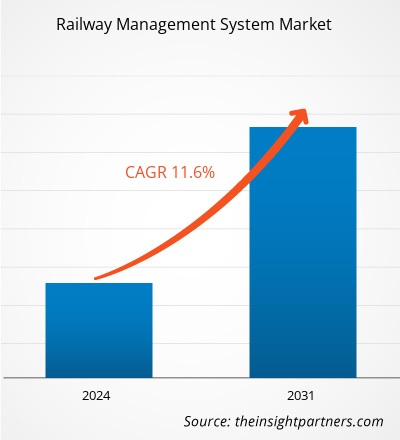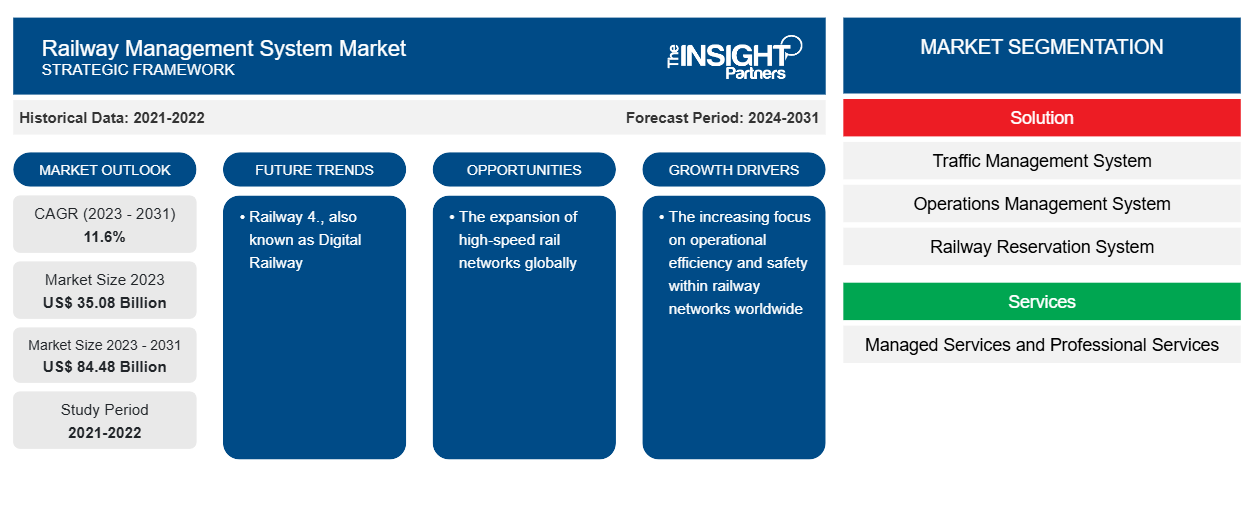Si prevede che la dimensione del mercato dei sistemi di gestione ferroviaria raggiungerà gli 84,48 miliardi di dollari entro il 2031, rispetto ai 35,08 miliardi di dollari del 2023. Si prevede che il mercato registrerà un CAGR dell'11,6% nel 2023-2031. La ferrovia 4.0, nota anche come ferrovia digitale, rimarrà probabilmente una delle principali tendenze del mercato dei sistemi di gestione ferroviaria.
Analisi di mercato del sistema di gestione ferroviaria
Il mercato dei sistemi di gestione ferroviaria sta crescendo grazie a varie tendenze nello sviluppo delle infrastrutture e nella tecnologia dei trasporti. Questi sistemi si concentrano sull'efficienza operativa, sul miglioramento della sicurezza e sull'esperienza dei passeggeri rispetto a funzionalità quali monitoraggio in tempo reale e manutenzione predittiva. Diverse tecnologie stanno guidando il mercato, tra cui AI (intelligenza artificiale), IoT (Internet of Things) e cloud computing, che consentono l'ottimizzazione e la gestione da remoto delle operazioni ferroviarie. Nel complesso, il mercato dei sistemi di gestione ferroviaria sta crescendo e si sta espandendo a livello globale, guidato dall'imperativo di migliorare l'efficienza ferroviaria, la sicurezza e la sostenibilità.
Panoramica del mercato dei sistemi di gestione ferroviaria
Un sistema di gestione ferroviaria comprende diversi processi e tecnologie per gestire e operare in modo efficiente le reti ferroviarie. Include componenti quali gestione del trasporto merci, sistemi di biglietteria , informazioni ai passeggeri, programmazione dei treni, programmazione della manutenzione e monitoraggio della sicurezza. Il sistema utilizza tecnologie avanzate, quali GPS, reti di comunicazione e sensori IoT per consentire di ottimizzare la pianificazione del percorso, garantire la sicurezza e il monitoraggio in tempo reale dei treni. I servizi ai passeggeri sono migliorati tramite prenotazione dei posti, prenotazione online dei biglietti e aggiornamenti in tempo reale sugli orari dei treni. Inoltre, le attività di manutenzione sono razionalizzate e riducono i tempi di fermo e migliorano l'efficienza operativa complessiva mediante l'utilizzo di tecniche di manutenzione predittiva.
Personalizza questo report in base alle tue esigenze
Riceverai la personalizzazione gratuita di qualsiasi report, comprese parti di questo report, o analisi a livello nazionale, pacchetto dati Excel, oltre a usufruire di grandi offerte e sconti per start-up e università
-
Scopri le principali tendenze di mercato in questo rapporto.Questo campione GRATUITO includerà analisi di dati che spaziano dalle tendenze di mercato alle stime e alle previsioni.
Driver e opportunità del mercato dei sistemi di gestione ferroviaria
La crescente attenzione all’efficienza operativa e alla sicurezza nelle reti ferroviarie in tutto il mondo
Con volumi crescenti di passeggeri e merci, gli operatori ferroviari si stanno rivolgendo a sistemi di gestione avanzati per ottimizzare la programmazione dei treni, la manutenzione dei binari e le prestazioni complessive della rete. Questi sistemi sfruttano tecnologie come sensori IoT, analisi predittive e monitoraggio in tempo reale per migliorare la sicurezza, ridurre al minimo i ritardi e ridurre i costi operativi. Migliorando l'efficienza e l'affidabilità, i sistemi di gestione ferroviaria aiutano a soddisfare le crescenti aspettative dei clienti e gli standard normativi.IoT sensors, predictive analytics, and real-time monitoring to enhance safety, minimize delays, and reduce operational costs. By improving efficiency and reliability, railway management systems help meet rising customer expectations and regulatory standards.
L'espansione delle reti ferroviarie ad alta velocità a livello globale
Molti paesi stanno investendo nella modernizzazione delle loro infrastrutture ferroviarie per supportare i treni ad alta velocità, offrendo opzioni di trasporto più rapide e sostenibili. Questa tendenza crea una domanda significativa di soluzioni avanzate di gestione ferroviaria in grado di gestire operazioni complesse a velocità più elevate e garantire una connettività senza interruzioni tra diverse reti ferroviarie. Mentre i progetti ferroviari ad alta velocità continuano ad espandersi, il mercato dei sistemi innovativi di gestione ferroviaria è pronto per una crescita sostanziale. Pertanto, si prevede che l'espansione delle reti ferroviarie ad alta velocità a livello globale presenterà nuove opportunità per gli operatori del mercato dei sistemi di gestione ferroviaria durante il periodo di previsione.
Analisi della segmentazione del rapporto di mercato del sistema di gestione ferroviaria
I segmenti chiave che hanno contribuito alla derivazione dell'analisi di mercato del sistema di gestione ferroviaria sono la soluzione e il tipo di implementazione.
- In base alla soluzione, il mercato dei sistemi di gestione ferroviaria è segmentato in sistemi di gestione del traffico, sistemi di gestione delle operazioni, sistemi di prenotazione ferroviaria, sistemi di informazione ai passeggeri, sistemi di gestione della manutenzione e altri.
- In base ai servizi, il mercato dei sistemi di gestione ferroviaria è segmentato in servizi gestiti e servizi professionali.
- In base al tipo di distribuzione, il mercato è segmentato in on-premise e cloud. Il segmento cloud ha detenuto una quota di mercato maggiore nel 2023.
Analisi della quota di mercato del sistema di gestione ferroviaria per area geografica
L'ambito geografico del rapporto di mercato sui sistemi di gestione ferroviaria è suddiviso principalmente in cinque regioni: Nord America, Asia Pacifico, Europa, Medio Oriente e Africa e Sud America/Sud e Centro America. In termini di fatturato, l'Europa ha rappresentato la quota di mercato maggiore dei sistemi di gestione ferroviaria. In Europa, le reti ferroviarie consolidate e l'attenzione all'efficienza guidano la domanda di sistemi di gestione avanzati che migliorino la sicurezza, la puntualità e l'esperienza dei passeggeri. Paesi come Germania e Francia sono leader nell'adozione di tecnologie all'avanguardia per il controllo, la segnalazione e la manutenzione dei treni.
Approfondimenti regionali sul mercato dei sistemi di gestione ferroviaria
Le tendenze regionali e i fattori che influenzano il Railway Management System Market durante il periodo di previsione sono stati ampiamente spiegati dagli analisti di Insight Partners. Questa sezione discute anche i segmenti del Railway Management System Market e la geografia in Nord America, Europa, Asia Pacifico, Medio Oriente e Africa e Sud e Centro America.

- Ottieni i dati specifici regionali per il mercato dei sistemi di gestione ferroviaria
Ambito del rapporto di mercato del sistema di gestione ferroviaria
| Attributo del report | Dettagli |
|---|---|
| Dimensioni del mercato nel 2023 | 35,08 miliardi di dollari USA |
| Dimensioni del mercato entro il 2031 | 84,48 miliardi di dollari USA |
| CAGR globale (2023-2031) | 11,6% |
| Dati storici | 2021-2022 |
| Periodo di previsione | 2024-2031 |
| Segmenti coperti |
Per soluzione
|
| Regioni e Paesi coperti |
America del Nord
|
| Leader di mercato e profili aziendali chiave |
|
Densità degli attori del mercato del sistema di gestione ferroviaria: comprendere il suo impatto sulle dinamiche aziendali
Il mercato del Railway Management System Market sta crescendo rapidamente, spinto dalla crescente domanda degli utenti finali dovuta a fattori quali l'evoluzione delle preferenze dei consumatori, i progressi tecnologici e una maggiore consapevolezza dei vantaggi del prodotto. Con l'aumento della domanda, le aziende stanno ampliando le loro offerte, innovando per soddisfare le esigenze dei consumatori e capitalizzando sulle tendenze emergenti, il che alimenta ulteriormente la crescita del mercato.
La densità degli operatori di mercato si riferisce alla distribuzione di aziende o società che operano in un particolare mercato o settore. Indica quanti concorrenti (operatori di mercato) sono presenti in un dato spazio di mercato in relazione alle sue dimensioni o al valore di mercato totale.
Le principali aziende che operano nel mercato dei sistemi di gestione ferroviaria sono:
- Bombardier, Inc.
- Società di tecnologia DXC
- EKE-Elettronica Ltd
- Compagnia elettrica generale
- Hitachi, Ltd.
- Società anonima Huawei
Disclaimer : le aziende elencate sopra non sono classificate secondo un ordine particolare.

- Ottieni una panoramica dei principali attori del mercato dei sistemi di gestione ferroviaria
Notizie di mercato e sviluppi recenti del sistema di gestione ferroviaria
Il mercato dei sistemi di gestione ferroviaria viene valutato raccogliendo dati qualitativi e quantitativi post-ricerca primaria e secondaria, che includono importanti pubblicazioni aziendali, dati associativi e database. Di seguito è riportato un elenco degli sviluppi nel mercato dei disturbi e delle strategie del linguaggio e della parola:
- Ad agosto 2023, Toast, la piattaforma tecnologica all-in-one creata per i ristoranti, ha annunciato il lancio di Toast Catering & Events, un nuovo prodotto completamente integrato con il punto vendita (POS) Toast per aiutare i ristoranti a gestire senza problemi grandi ordini di catering e pianificazione di eventi. Toast Catering & Events supporta ordini di eventi per banchetti personalizzabili (BEO), strumenti di evasione e funzionalità di gestione dei lead. (Fonte: Toast, comunicato stampa)
- A giugno 2021, FoodStorm, il principale fornitore di software per la ristorazione al mondo, ha annunciato il lancio del suo FoodStorm Kiosk, un chiosco fisico self-service che consente ai clienti in negozio di effettuare ordini di catering, cibo pronto, gastronomia e prodotti da forno con un unico back-end gestito. (Fonte: FoodStorm, comunicato stampa)
Copertura e risultati del rapporto di mercato sul sistema di gestione ferroviaria
Il rapporto "Dimensioni e previsioni del mercato del sistema di gestione ferroviaria (2023-2031)" fornisce un'analisi dettagliata del mercato che copre le seguenti aree:
- Dimensioni e previsioni del mercato a livello globale, regionale e nazionale per tutti i segmenti di mercato chiave coperti dall'ambito
- Dinamiche di mercato come fattori trainanti, vincoli e opportunità chiave
- Principali tendenze future
- Analisi dettagliata delle cinque forze PEST/Porter e SWOT
- Analisi di mercato globale e regionale che copre le principali tendenze di mercato, i principali attori, le normative e gli sviluppi recenti del mercato
- Analisi del panorama industriale e della concorrenza che copre la concentrazione del mercato, l'analisi della mappa di calore, i principali attori e gli sviluppi recenti
- Profili aziendali dettagliati
- Analisi storica (2 anni), anno base, previsione (7 anni) con CAGR
- Analisi PEST e SWOT
- Valore/volume delle dimensioni del mercato - Globale, Regionale, Nazionale
- Industria e panorama competitivo
- Set di dati Excel
Report recenti
Rapporti correlati
Testimonianze
Motivo dell'acquisto
- Processo decisionale informato
- Comprensione delle dinamiche di mercato
- Analisi competitiva
- Analisi dei clienti
- Previsioni di mercato
- Mitigazione del rischio
- Pianificazione strategica
- Giustificazione degli investimenti
- Identificazione dei mercati emergenti
- Miglioramento delle strategie di marketing
- Aumento dell'efficienza operativa
- Allineamento alle tendenze normative























 Ottieni un campione gratuito per - Mercato dei sistemi di gestione ferroviaria
Ottieni un campione gratuito per - Mercato dei sistemi di gestione ferroviaria